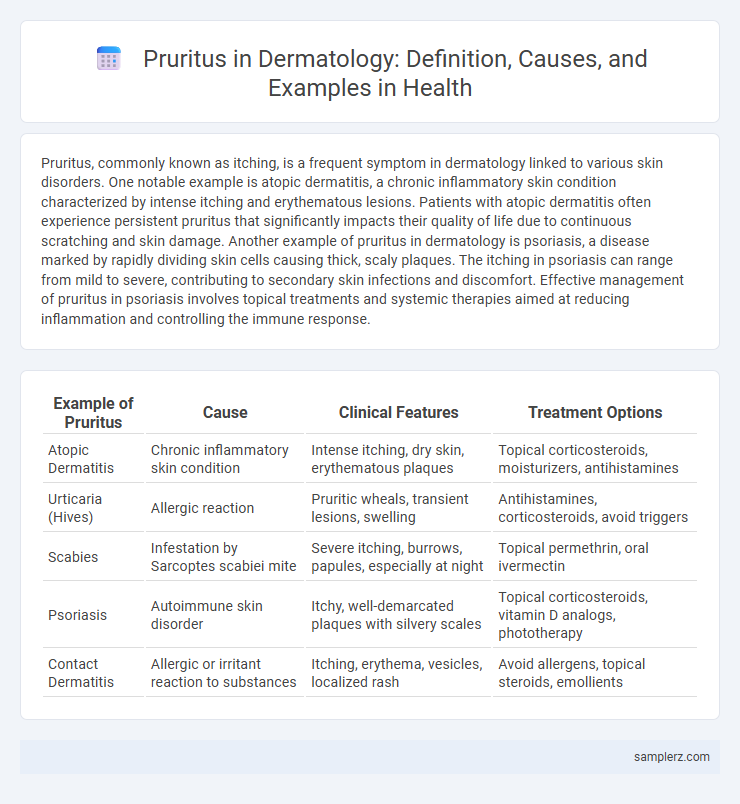Pruritus, commonly known as itching, is a frequent symptom in dermatology linked to various skin disorders. One notable example is atopic dermatitis, a chronic inflammatory skin condition characterized by intense itching and erythematous lesions. Patients with atopic dermatitis often experience persistent pruritus that significantly impacts their quality of life due to continuous scratching and skin damage. Another example of pruritus in dermatology is psoriasis, a disease marked by rapidly dividing skin cells causing thick, scaly plaques. The itching in psoriasis can range from mild to severe, contributing to secondary skin infections and discomfort. Effective management of pruritus in psoriasis involves topical treatments and systemic therapies aimed at reducing inflammation and controlling the immune response.
Table of Comparison
| Example of Pruritus | Cause | Clinical Features | Treatment Options |
|---|---|---|---|
| Atopic Dermatitis | Chronic inflammatory skin condition | Intense itching, dry skin, erythematous plaques | Topical corticosteroids, moisturizers, antihistamines |
| Urticaria (Hives) | Allergic reaction | Pruritic wheals, transient lesions, swelling | Antihistamines, corticosteroids, avoid triggers |
| Scabies | Infestation by Sarcoptes scabiei mite | Severe itching, burrows, papules, especially at night | Topical permethrin, oral ivermectin |
| Psoriasis | Autoimmune skin disorder | Itchy, well-demarcated plaques with silvery scales | Topical corticosteroids, vitamin D analogs, phototherapy |
| Contact Dermatitis | Allergic or irritant reaction to substances | Itching, erythema, vesicles, localized rash | Avoid allergens, topical steroids, emollients |
Common Causes of Pruritus in Dermatology
Pruritus in dermatology commonly arises from conditions such as atopic dermatitis, psoriasis, and contact dermatitis, where skin inflammation triggers intense itching. Other prevalent causes include xerosis (dry skin), scabies infestation, and urticaria, each contributing to persistent discomfort through different pathological mechanisms. Identifying the underlying cause of pruritus is crucial for effective management and relief of symptoms in affected patients.
Atopic Dermatitis: A Classic Case of Pruritus
Atopic dermatitis, a chronic inflammatory skin condition, exemplifies pruritus by causing intense, persistent itching that significantly impairs quality of life. The underlying pathophysiology involves disrupted skin barrier function and immune dysregulation, leading to xerosis and elevated serum IgE levels. Effective management targets symptom relief through emollients, topical corticosteroids, and antihistamines to mitigate pruritic episodes and prevent secondary infections.
Contact Dermatitis and Itchy Skin
Pruritus is a common symptom in dermatology, often manifesting prominently in conditions like Contact Dermatitis, where exposure to allergens or irritants triggers intense itchy skin. This inflammatory response causes the release of histamines and cytokines, leading to erythema, swelling, and persistent itching. Effective management includes identifying and avoiding the offending agents alongside topical corticosteroids to reduce inflammation and alleviate pruritus.
Pruritus in Psoriasis: Key Dermatological Insights
Pruritus in psoriasis affects up to 90% of patients, presenting as intense itching that exacerbates skin inflammation and lesion severity. This symptom is linked to neuroimmune interactions involving pro-inflammatory cytokines such as IL-31 and TNF-alpha, which contribute to nerve sensitization in psoriatic plaques. Effective management includes targeting these molecular pathways alongside conventional treatments like topical corticosteroids and phototherapy to reduce itching and improve quality of life.
Urticaria: Acute and Chronic Itching Episodes
Urticaria, commonly known as hives, is characterized by acute and chronic itching episodes resulting from histamine release in the skin. These episodes present as raised, erythematous wheals often accompanied by intense pruritus, impacting patient quality of life. Management includes antihistamines and identifying triggering factors such as allergens, infections, or stress to reduce the frequency and severity of outbreaks.
Lichen Planus: Characteristic Pruritus Patterns
Lichen Planus presents with intense, localized pruritus primarily affecting the wrists, ankles, and oral mucosa, reflecting its inflammatory nature. This chronic dermatological condition triggers neuropathic itch pathways, often exacerbating skin damage through scratching. Understanding these characteristic pruritus patterns aids in targeted symptom management and improves patient quality of life.
Fungal Skin Infections and Associated Itch
Pruritus in dermatology often manifests prominently in fungal skin infections such as tinea corporis and candidiasis, where the fungal invasion triggers intense itching due to inflammatory responses. Dermatophytes like Trichophyton and Microsporum species induce keratin degradation, leading to skin barrier disruption and subsequent pruritic sensations. Effective antifungal treatment reduces fungal load and inflammation, thereby alleviating the associated pruritus and improving patient comfort.
Xerosis (Dry Skin) and Pruritus in the Elderly
Xerosis is a common cause of pruritus in the elderly, characterized by dry, flaky skin resulting from reduced natural oils and decreased skin hydration. This condition often leads to intense itching and discomfort, exacerbating skin barrier dysfunction and increasing susceptibility to infections. Effective management includes regular use of emollients and hydration strategies to restore skin moisture and alleviate pruritic symptoms.
Systemic Diseases Manifesting as Pruritus
Systemic diseases such as chronic kidney disease, cholestatic liver disorders, and hematologic malignancies frequently manifest pruritus as a primary dermatologic symptom. Uremic pruritus in end-stage renal disease and cholestatic pruritus in conditions like primary biliary cholangitis are common examples where systemic pathology triggers intense itching. Identifying pruritus linked to systemic diseases is crucial for early diagnosis and targeted treatment, reducing patient morbidity.
Emerging Treatments for Pruritic Skin Disorders
Emerging treatments for pruritic skin disorders include targeted biologics such as dupilumab, which inhibits IL-4 and IL-13 pathways involved in atopic dermatitis-associated pruritus. JAK inhibitors like upadacitinib and baricitinib show promising results by modulating cytokine signaling implicated in chronic itch signaling pathways. Novel therapies focusing on neuroimmune interactions and pruritogen receptors, such as NK1 receptor antagonists, are also gaining attention for alleviating refractory pruritus in dermatology.

example of pruritus in dermatology Infographic
 samplerz.com
samplerz.com